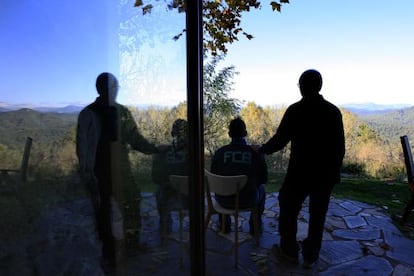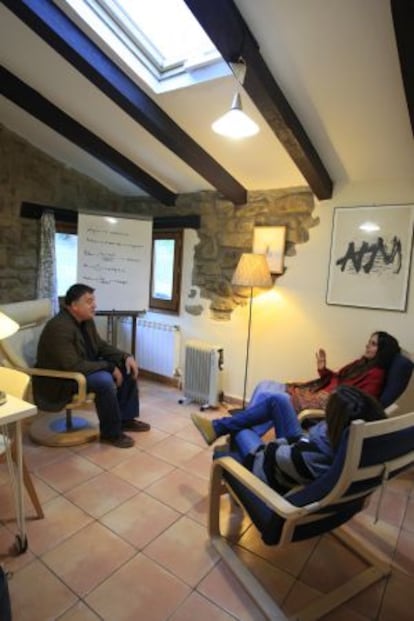Spain¡¯s invisible drug problem
While narcotics use is no longer seen as a danger, experts say it¡¯s become overly accepted

Spanish police last year seized 120 percent more amphetamines, 28 percent more cocaine and 3.2 percent more heroin than they did in 2012. The increases have raised fears that although the use of illegal substances has stabilized in recent years, consumption could easily be driven upward by cheap and plentiful supply
In the 1980s, government policies to decriminalize the use, but not the supply, of hard drugs sparked a heroin addiction epidemic that saw HIV rates soar. Since then, says Dr Xavier F¨¤bregas, who runs the Mas Ferriol drug and alcohol addiction treatment center in the small town of Falgons, Girona, Spaniards have largely ignored the issue, more concerned in recent years about the impact of the economic crisis.
¡°It¡¯s as though we had gotten used to drug use, as though society no longer considered addiction a problem, unless of course it affects someone close to you,¡± says F¨¤bregas, who has more than three decades of experience in treating addiction.
Heroin in Spain is consumed by barely 0.1 percent of the population, and no longer generates alarm. Instead, today¡¯s drugs are mainly associated with leisure, taken in clubs and bars: ¡°Which doesn¡¯t make them any less serious,¡± warns F¨¤bregas.
It¡¯s as though we had gotten used to drug use, as though society no longer considered addiction a problem¡± Dr. Xavier F¨¤bregas, head of the Mas Ferriol treatment center
EL PA?S spent three days at Dr. F¨¤bregas¡¯ clinic, talking to patients from all walks of life and social strata. Some of them are undergoing treatment for alcoholism, such as P.T., a 58-year-old architect who began drinking when the crisis kicked in and work began to dry up. It soon took up all his time, and now, six years later, he is divorced and jobless.
M¨¢s Ferriol, which sits in the foothills of the Pyrenees, offers individual and group therapy sessions, along with invigorating walks along the trails through nearby woods in the company of Rex, an Alsatian dog who plays a big role in some patients¡¯ treatment. The clinic also provides treatment for growing numbers of young people who have become heavily dependent on marijuana.
¡°I started drinking alcohol and smoking joints when I was 14,¡± says C.R., who is now 30 and receiving treatment for alcohol addiction at Mas Ferriol. ¡°There were around 15 of us. Most of the time, we just hung out, smoking by the school gates, and didn¡¯t bother going to class. When we did go, we didn¡¯t understand what we were being taught because we were stoned. In the end, none of us graduated from high school.¡± Four members of his group ended up being treated for cocaine use, he says, while others went on to lead more or less normal lives, marrying and having children. ¡°The worst thing about becoming dependent on drugs is that you just don¡¯t grow up; you remain a teenager and never learn to control your emotions or how to sort your problems out for yourself.¡±

Another patient, aged 17, has suffered psychotic episodes triggered by smoking large amounts of marijuana each day for the past three years, and dropping out of school in the process. ¡°Sadly, we are seeing more and more cases of what we call dual pathology: depression, anxiety, psychosis, etc, as well as the substance abuse itself,¡± says F¨¤bregas.
Back in the 1980s, marijuana was barely considered a drug by the authorities, and people openly smoked joints in public places throughout Spain. ¡°But we now know that sustained use of cannabis, particularly during adolescence, can have damaging results,¡± says F¨¤bregas. ¡°A third of requests for treatment at the clinic these days are related to cannabis abuse, which would have been unthinkable two decades ago. But the figures show that one in three school students aged between 14 and 18 has consumed hashish or marijuana at least once.¡± Of this age group, he says, around 16 percent regularly smoke, and their use could be described as problematic: ¡°their studies suffer and they get into other drugs.¡±
The figures relating to alcohol abuse for the same age group are even more alarming, says Francisco Bab¨ªn, the government¡¯s representative on the National Drugs Plan: ¡°Around 81 percent say they have consumed alcohol in the last year, and half have already been drunk at least once.¡± He agrees with?F¨¤bregas that Spanish society has become ¡°complacent¡± about drugs.
When F¨¤bregas began working in 1984, almost all his clients were heroin addicts. ¡°Smack was tearing Spain apart: dozens of young people were dying each month from overdoses, there were muggings and bank robberies, addicts were holding up pharmacies every day; and then in 1986, AIDS kicked in,¡± he explains. Spain¡¯s newly democratizing society was stunned.?F¨¤bregas says that opinion polls from the time showed that half of Spaniards saw drugs as the country¡¯s second-biggest problem. Unemployment was the number one issue, and public safety the third, largely prompted by the sharp rise in burglaries and muggings by addicts.
The most recent poll by the Center for Sociological Research (CIS) from October of this year puts the main concern of Spaniards as unemployment, with corruption and politics in second and third places. Drug abuse comes almost at the bottom of a list of around 50 issues. It¡¯s only considered a problem for 0.3 percent of those polled.
¡°People have forgotten what happened, and that¡¯s very dangerous,¡± says R.O., a 61-year-old former drug addict who is undergoing treatment at Mas Ferriol for alcohol and marijuana abuse ¨C ¡°I¡¯m a bad junkie, but a successful alcoholic,¡± he jokes.
In many ways, his story mirrors that of drug abuse in Spain. Born into a wealthy family, he began smoking hashish in the 1970s, and soon moved on to heroin. ¡°In those days, drug taking was for the elite, almost a philosophical thing. You had to travel to India, listen to Lou Reed, read William Burroughs, Kerouac,¡± he says. ¡°Then, in the 1980s, heroin became widely available, and in the 1990s, with the economic boom, cocaine was cheap and plentiful.¡±
R.O. managed to get off heroin, but instead became a heavy cocaine user, sometimes snorting as much as five grams a day, or more. ¡°Heroin was something that went deep inside you, but cocaine is an extrovert drug, the drug of success ¨C you needed money, you had a good time, and could stay up partying all night, it reflected the zeitgeist of excess in Spain at the time,¡± he says.
By the time anybody realized the dangers, it was too late, says Bab¨ªn: ¡°Around 100,000 people are under treatment for some kind of addiction in Spain each year, and of them, around a third have problems with cocaine; another third is for cannabis, and the remainder alcohol and other drugs.¡±
The worst thing about becoming dependent on drugs is that you just don¡¯t grow up; you remain a teenager¡± Mas Ferriol patient C.R., aged 30
Earlier this year, Giovanna Valls, the sister of French Prime Minister Manuel Valls, published the story of her battle with heroin addiction, Aferrada a la vida (Clinging to life). The introduction includes a letter of thanks to Xavier?F¨¤bregas for his help in freeing herself from addiction. Like him, she too warns that society is overlooking a growing problem, one to which the current economic crisis is contributing.
¡°Half of young people are out of work, a lot of them are not studying, and all they see on television are advertisements for things that they are never going to be able to afford. Add to that a feeling of resignation, because there is no sign that any of this is going to get better, and we are sitting on a time bomb,¡± says R.O..
Eusebio Meg¨ªas, the technical director of the Foundation for Help Against Drugs (FAD), does not believe that heroin is going to make a comeback in Spain, but that the country still faces a serious threat from the spread of recreational drug use. ¡°Drug consumption has become a cultural phenomenon: people take them as though they were just another way of having fun. They take drugs to get on with their friends, and to be able to stay up all night partying,¡± he says.
Meg¨ªas shares the concerns of others involved in the fight against drug consumption that the issue has been ¡°trivialized,¡± pointing out that use is openly shown as unproblematic in films and television series. But at the same time, he doesn¡¯t believe that society is unaware of the problem: ¡°We carried out a survey recently, asking people if they thought drugs were a serious problem and that young people should never experiment, and 60 percent agreed.¡±
Today drug abuse comes almost at the bottom of the list of Spaniards¡¯ main concerns
It¡¯s not that people underestimate the problem; it¡¯s that society has become used to living with drugs. ¡°It¡¯s gone from being a visible problem to being a personal problem,¡± says Paco Recio, the director general of Proyecto Hombre, which has helped around a quarter of a million drug users over the last 25 years. He admits that we are never going to have a drug-free society, but says that education and prevention can play a ¡°vital role.¡±
If the problem in the 1980s was to stop the heroin epidemic, and in the 1990s the challenge was to raise awareness about the dangers of cocaine, today the task is to fight to eradicate ¡°the day-to-day drugs such as alcohol and cannabis, and for society to understand that a healthy life is a better life,¡± says Recio.
Night falls in Mas Ferriol. Over the last three decades, treatment and therapy here has changed considerably, says F¨¤bregas. ¡°Before, people used to stay for much longer; there were people in and out of treatment for years, but nowadays we try to get patients back into the community as quickly as possible, and here, for example, the longest stays are now six weeks.¡±
F¨¤bregas?says he will continue fighting against what he calls the ¡°banalization¡± of drugs, helping ordinary people deal with addiction, the result of what happens when society forgets the dangers that threaten it from within.
Tu suscripci¨®n se est¨¢ usando en otro dispositivo
?Quieres a?adir otro usuario a tu suscripci¨®n?
Si contin¨²as leyendo en este dispositivo, no se podr¨¢ leer en el otro.
FlechaTu suscripci¨®n se est¨¢ usando en otro dispositivo y solo puedes acceder a EL PA?S desde un dispositivo a la vez.
Si quieres compartir tu cuenta, cambia tu suscripci¨®n a la modalidad Premium, as¨ª podr¨¢s a?adir otro usuario. Cada uno acceder¨¢ con su propia cuenta de email, lo que os permitir¨¢ personalizar vuestra experiencia en EL PA?S.
En el caso de no saber qui¨¦n est¨¢ usando tu cuenta, te recomendamos cambiar tu contrase?a aqu¨ª.
Si decides continuar compartiendo tu cuenta, este mensaje se mostrar¨¢ en tu dispositivo y en el de la otra persona que est¨¢ usando tu cuenta de forma indefinida, afectando a tu experiencia de lectura. Puedes consultar aqu¨ª los t¨¦rminos y condiciones de la suscripci¨®n digital.








































